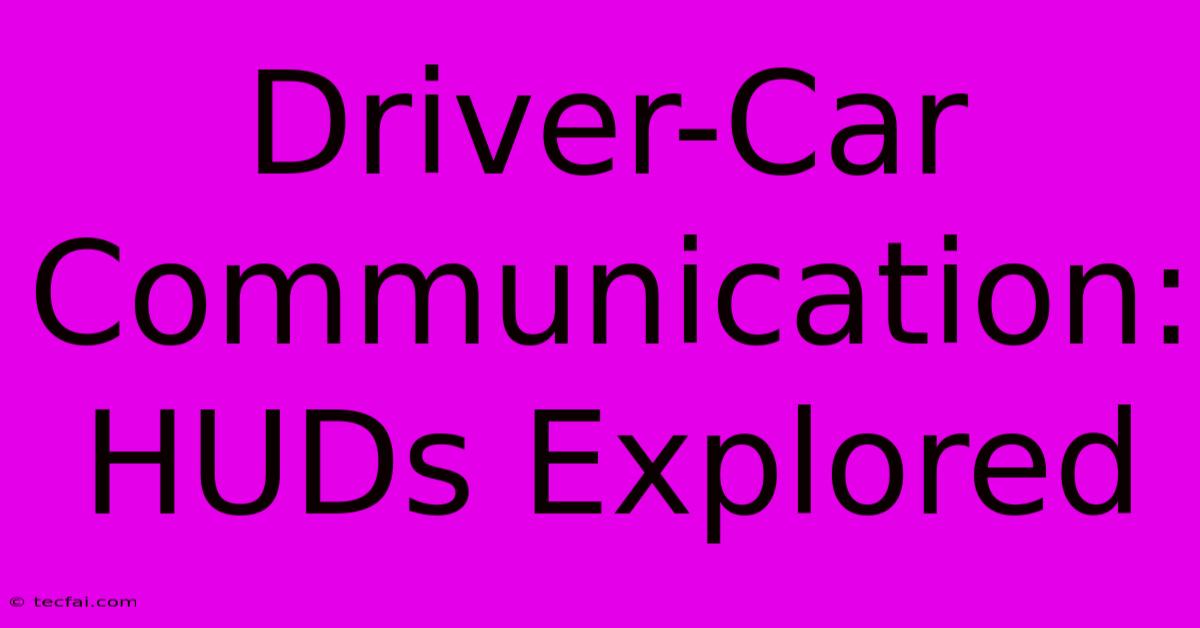Driver-Car Communication: HUDs Explored

Discover more detailed and exciting information on our website. Click the link below to start your adventure: Visit Best Website tecfai.com. Don't miss out!
Table of Contents
Driver-Car Communication: HUDs Explored
The relationship between driver and vehicle is evolving rapidly. No longer is it simply a matter of steering wheel, pedals, and gears. Modern cars are becoming increasingly sophisticated, demanding more nuanced communication between the driver and the machine. Head-Up Displays (HUDs) are at the forefront of this revolution, offering a safer and more intuitive driving experience. This article delves into the world of HUDs, exploring their functionalities, benefits, and future potential.
What is a Head-Up Display (HUD)?
A Head-Up Display projects crucial driving information onto the windshield or a transparent panel in the driver's line of sight. This allows drivers to keep their eyes on the road while still accessing vital data, reducing distractions and improving safety. Think of it as a miniature, customizable dashboard hovering directly in front of you.
Key Information Displayed by HUDs:
- Speed: A fundamental piece of information, clearly displayed without the driver needing to look down at the instrument cluster.
- Navigation: Turn-by-turn directions, simplifying navigation and reducing the need for constant glances at a separate GPS device.
- ADAS alerts: Warnings from Advanced Driver-Assistance Systems (ADAS), such as lane departure warnings, blind-spot monitoring alerts, and collision warnings. These are presented directly in the driver's field of vision, enhancing reaction time.
- Engine data: RPM, fuel level, and other engine metrics can be displayed, providing a more comprehensive understanding of vehicle performance.
- Entertainment information: Some HUDs can even display basic information from the infotainment system, such as incoming calls or music selections.
Benefits of using a HUD
The advantages of HUD technology are numerous and impactful:
- Enhanced Safety: By reducing the need to look away from the road, HUDs significantly improve driver safety, minimizing distractions and response times to potential hazards. This is particularly crucial in challenging driving conditions.
- Improved Situational Awareness: Having critical information readily available in your line of sight leads to better awareness of your surroundings and your vehicle's status.
- Reduced Eye Strain: The projection of information onto the windshield means less eye movement between the road and the dashboard, minimizing eye strain during long drives.
- Increased Comfort and Convenience: The easy accessibility of information enhances the overall driving experience, making it more comfortable and less stressful.
Different Types of HUDs
The market offers a variety of HUDs, each with its own set of features and price points.
- Factory-installed HUDs: These are integrated directly into the vehicle's design during manufacturing, offering seamless integration and often advanced features.
- Aftermarket HUDs: These are standalone units that can be added to almost any car, providing a more affordable entry point to HUD technology. However, integration may not be as seamless.
- Windshield-projected HUDs: These project the information directly onto the windshield, providing a clear and unobstructed view.
- Combiner-type HUDs: These utilize a transparent combiner that sits in front of the driver, projecting the information onto the combiner's surface.
The Future of Driver-Car Communication with HUDs
The future of HUDs is bright. Expect to see continued advancements in:
- Augmented Reality (AR) HUDs: These will overlay digital information onto a real-world view, providing more immersive and contextual information. Imagine seeing directions projected directly onto the road ahead.
- Improved Graphics and Resolution: HUDs will continue to improve in terms of image quality, making the information clearer and easier to read.
- Greater Integration with ADAS: Expect even tighter integration with ADAS features, providing drivers with more comprehensive and timely alerts.
Conclusion
Head-Up Displays represent a significant leap forward in driver-car communication. By providing critical information in a safe and intuitive manner, HUDs are enhancing safety, improving situational awareness, and ultimately making the driving experience more enjoyable. As technology continues to advance, the role of HUDs in the automotive landscape will only grow, shaping the future of driving for years to come.

Thank you for visiting our website wich cover about Driver-Car Communication: HUDs Explored. We hope the information provided has been useful to you. Feel free to contact us if you have any questions or need further assistance. See you next time and dont miss to bookmark.
Featured Posts
-
Citys 3 Goal Lead Evaporates
Nov 27, 2024
-
South Africa Trails 79 4 Vs Sl
Nov 27, 2024
-
Algert Sells Nclh Shares
Nov 27, 2024
-
Vanderpump Rules Renewed Cast Changes Ahead
Nov 27, 2024
-
Aflca Names Crocker Coach Of Year
Nov 27, 2024
